Page 164 of 376
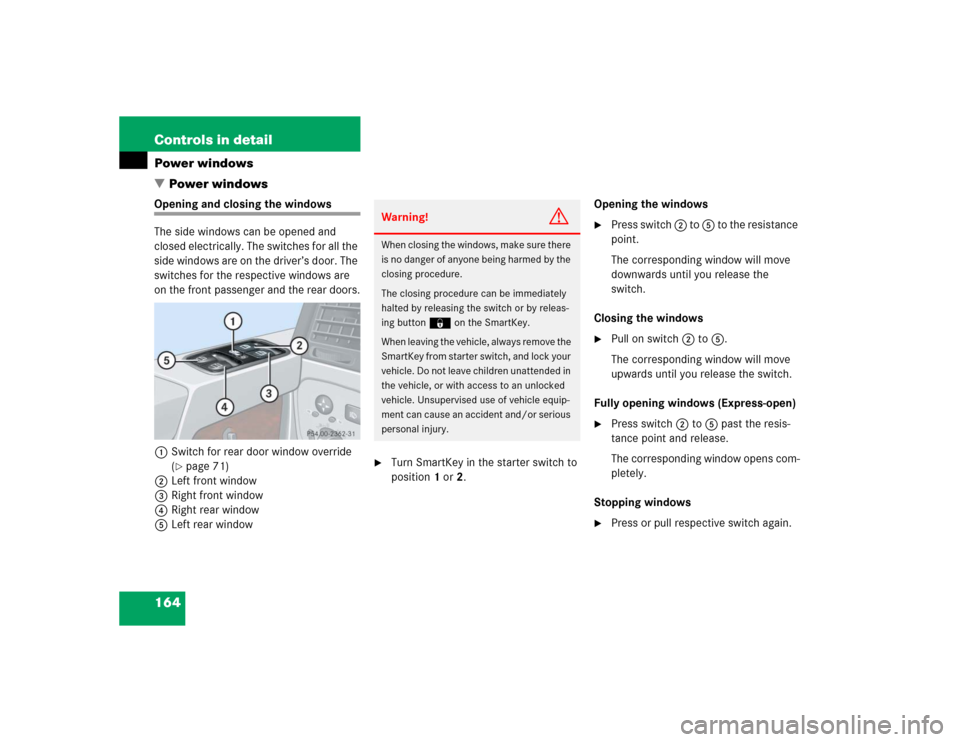
164 Controls in detailPower windows
�Power windowsOpening and closing the windows
The side windows can be opened and
closed electrically. The switches for all the
side windows are on the driver’s door. The
switches for the respective windows are
on the front passenger and the rear doors.
1Switch for rear door window override
(
�page 71)
2Left front window
3Right front window
4Right rear window
5Left rear window
�
Turn SmartKey in the starter switch to
position1 or2.Opening the windows
�
Press switch 2 to 5 to the resistance
point.
The corresponding window will move
downwards until you release the
switch.
Closing the windows
�
Pull on switch 2 to 5.
The corresponding window will move
upwards until you release the switch.
Fully opening windows (Express-open)
�
Press switch 2 to 5 past the resis-
tance point and release.
The corresponding window opens com-
pletely.
Stopping windows
�
Press or pull respective switch again.
Warning!
G
When closing the windows, make sure there
is no danger of anyone being harmed by the
closing procedure.
The closing procedure can be immediately
halted by releasing the switch or by releas-
ing button‹ on the SmartKey.
When leaving the vehicle, always remove the
SmartKey from starter switch, and lock your
vehicle. Do not leave children unattended in
the vehicle, or with access to an unlocked
vehicle. Unsupervised use of vehicle equip-
ment can cause an accident and/or serious
personal injury.
Page 165 of 376

165 Controls in detail
Power windows
Opening and closing windows with the
SmartKey
The sliding/pop-up roof (
�page 166) will
also be opened or closed when the power
windows are operated with the SmartKey.
�
Aim transmitter eye at the driver’s door
handle.Opening (Summer opening feature)
�
Press and hold buttonΠafter un-
locking the vehicle.
The windows and sliding/pop-up roof
begin to open after approximately one
second.
�
Release transmit button to interrupt
procedure.Closing (Convenience feature)
�
Press and hold button‹ after lock-
ing the vehicle.
The windows and sliding/pop-up roof
begin to close after approximately one
second.
�
Release transmit button to interrupt
procedure.
Make sure all side windows and the slid-
ing/pop-up roof are properly closed before
leaving the vehicle.
Warning!
G
Never operate the windows or slid-
ing/pop-up roof if there is the possibility of
anyone being harmed by the opening or
closing procedure.
In case the procedure causes potential dan-
ger, the procedure can be immediately halt-
ed by releasing the button on the SmartKey.
To reverse direction of movement,
pressŒ for opening or ‹ for closing.
Page 166 of 376
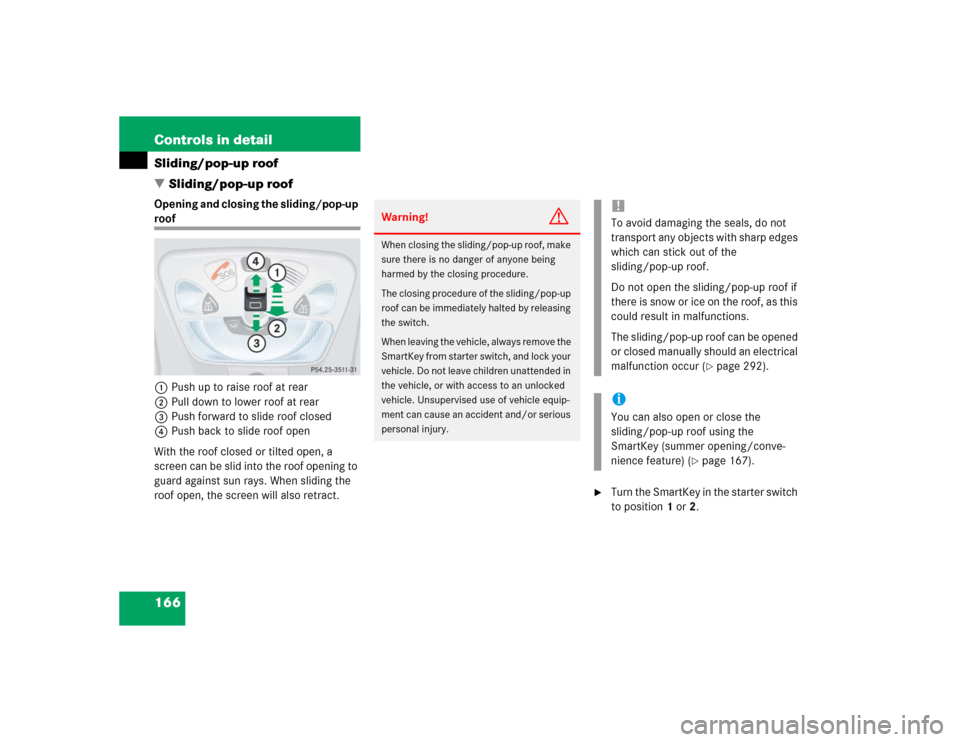
166 Controls in detailSliding/pop-up roof
�Sliding/pop-up roofOpening and closing the sliding/pop-up roof
1Push up to raise roof at rear
2Pull down to lower roof at rear
3Push forward to slide roof closed
4Push back to slide roof open
With the roof closed or tilted open, a
screen can be slid into the roof opening to
guard against sun rays. When sliding the
roof open, the screen will also retract.
�
Turn the SmartKey in the starter switch
to position1 or2.
Warning!
G
When closing the sliding/pop-up roof, make
sure there is no danger of anyone being
harmed by the closing procedure.
The closing procedure of the sliding/pop-up
roof can be immediately halted by releasing
the switch.
When leaving the vehicle, always remove the
SmartKey from starter switch, and lock your
vehicle. Do not leave children unattended in
the vehicle, or with access to an unlocked
vehicle. Unsupervised use of vehicle equip-
ment can cause an accident and/or serious
personal injury.
!To avoid damaging the seals, do not
transport any objects with sharp edges
which can stick out of the
sliding/pop-up roof.
Do not open the sliding/pop-up roof if
there is snow or ice on the roof, as this
could result in malfunctions.
The sliding/pop-up roof can be opened
or closed manually should an electrical
malfunction occur (
�page 292).
iYou can also open or close the
sliding/pop-up roof using the
SmartKey (summer opening/conve-
nience feature) (
�page 167).
Page 167 of 376

167 Controls in detail
Sliding/pop-up roof
Opening and closing the sliding/pop-up
roof�
To open, close, raise or lower the slid-
ing/pop-up roof, move the switch to
the resistance point in the required
direction1to4.
Release the switch when the roof has
reached the required position.Fully opening (Express-open)
�
To open the sliding/pop-up roof, move
the switch past the resistance point in
direction4 and release.
The sliding/pop up roof opens com-
pletely.
Stopping the sliding / pop-up roof
�
Move the switch in any direction.Opening and closing the sliding/pop-up
roof with the SmartKey
The power windows (
�page 164) will also
be opened or closed when you operate the
sliding/pop-up roof with the SmartKey.
�
Aim transmitter eye at the driver’s door
handle.
iIf the movement of the sliding/pop-up
roof is blocked during the closing pro-
cedure, the roof will stop and reopen
slightly.
Warning!
G
Never operate the windows or slid-
ing/pop-up roof if there is the possibility of
anyone being harmed by the opening or
closing procedure.
In case the procedure causes potential dan-
ger, the procedure can be immediately halt-
ed by releasing the button on the SmartKey.
To reverse direction of movement,
pressŒ for opening or ‹ for closing.
Page 169 of 376

169 Controls in detail
Driving systems
�Driving systems
The driving systems of your vehicle are de-
scribed on the following pages:�
Cruise control, with which the vehicle
can maintain a preset speed.
�
Rear Parking Assist*, with which you
can assist your parking maneuvers.
The BAS, ABS, ESP, 4-ETS and EBB driving
systems are described in the “Safety and
Security” section (
�page 74).
Cruise control
Cruise control automatically maintains the
speed you set for your vehicle.
Use of cruise control is recommended for
driving at a constant speed for extended
periods of time. You can set or resume
cruise control at any speed over 20 mph
(30 km/h).
The cruise control function is operated by
means of the cruise control lever.
The cruise control lever is the uppermost
lever found on the left-hand side of the
steering column (
�page 23).
iThe cruise control should not be acti-
vated during-off road driving.
Warning!
G
Cruise control is a convenience system de-
signed to assist the driver during vehicle op-
eration. The driver is and must always
remain responsible for the vehicle speed
and for safe brake operation.
Only use cruise control if the road, traffic
and weather conditions make it advisable to
travel at a steady speed.�
The use of cruise control can be danger-
ous on winding roads or in heavy traffic
because conditions do not allow safe
driving at a steady speed.
�
The use of cruise control can be danger-
ous on slippery roads. Rapid changes in
tire traction can result in wheel spin and
loss of control.
�
Deactivate cruise control when driving
in fog.
The “Resume” function should only be oper-
ated if the driver is fully aware of the previ-
ously set speed and wishes to resume this
particular preset speed.
Page 171 of 376
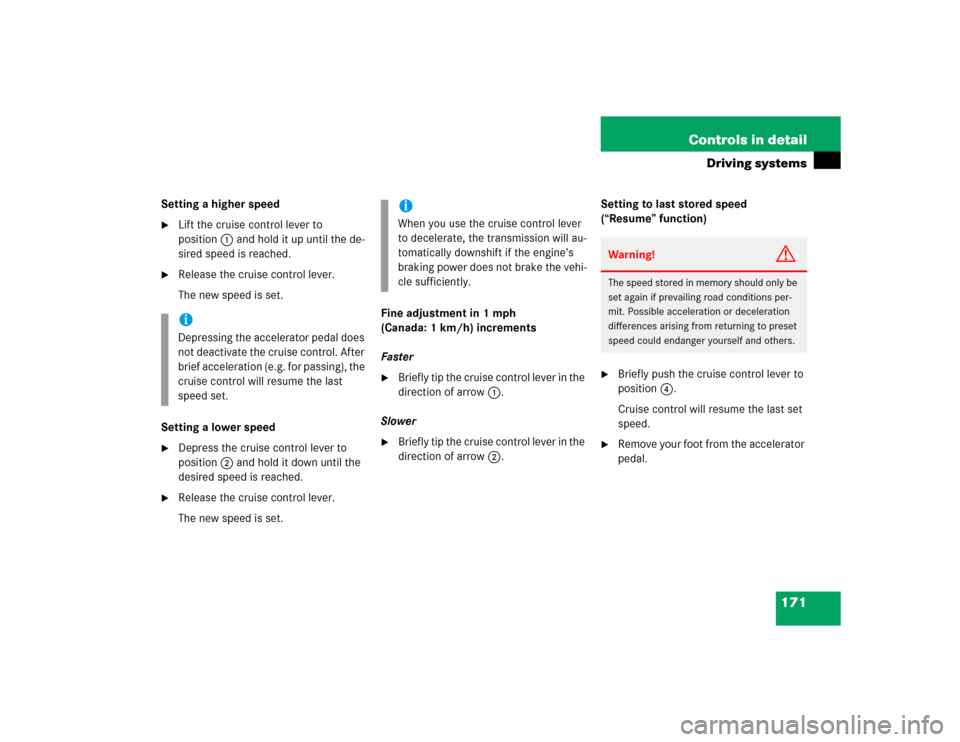
171 Controls in detail
Driving systems
Setting a higher speed�
Lift the cruise control lever to
position1 and hold it up until the de-
sired speed is reached.
�
Release the cruise control lever.
The new speed is set.
Setting a lower speed
�
Depress the cruise control lever to
position2 and hold it down until the
desired speed is reached.
�
Release the cruise control lever.
The new speed is set.Fine adjustment in 1 mph
(Canada: 1 km/h) increments
Faster
�
Briefly tip the cruise control lever in the
direction of arrow1.
Slower
�
Briefly tip the cruise control lever in the
direction of arrow2.Setting to last stored speed
(“Resume” function)
�
Briefly push the cruise control lever to
position4.
Cruise control will resume the last set
speed.
�
Remove your foot from the accelerator
pedal.
iDepressing the accelerator pedal does
not deactivate the cruise control. After
brief acceleration (e.g. for passing), the
cruise control will resume the last
speed set.
iWhen you use the cruise control lever
to decelerate, the transmission will au-
tomatically downshift if the engine’s
braking power does not brake the vehi-
cle sufficiently.
Warning!
G
The speed stored in memory should only be
set again if prevailing road conditions per-
mit. Possible acceleration or deceleration
differences arising from returning to preset
speed could endanger yourself and others.
Page 172 of 376
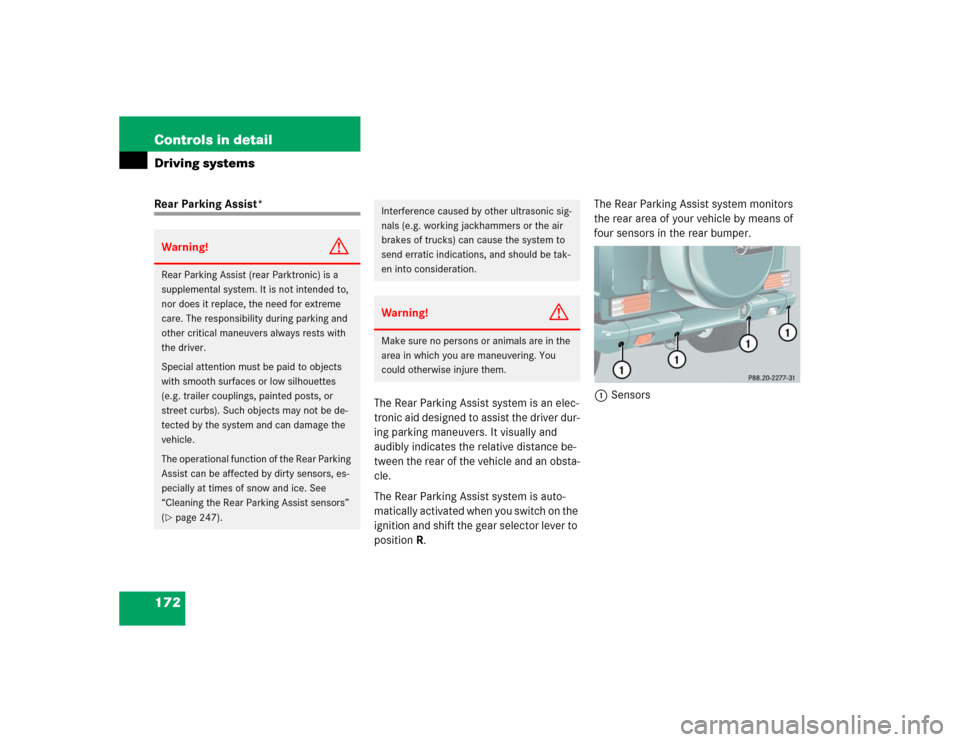
172 Controls in detailDriving systemsRear Parking Assist*
The Rear Parking Assist system is an elec-
tronic aid designed to assist the driver dur-
ing parking maneuvers. It visually and
audibly indicates the relative distance be-
tween the rear of the vehicle and an obsta-
cle.
The Rear Parking Assist system is auto-
matically activated when you switch on the
ignition and shift the gear selector lever to
positionR.The Rear Parking Assist system monitors
the rear area of your vehicle by means of
four sensors in the rear bumper.
1SensorsWarning!
G
Rear Parking Assist (rear Parktronic) is a
supplemental system. It is not intended to,
nor does it replace, the need for extreme
care. The responsibility during parking and
other critical maneuvers always rests with
the driver.
Special attention must be paid to objects
with smooth surfaces or low silhouettes
(e.g. trailer couplings, painted posts, or
street curbs). Such objects may not be de-
tected by the system and can damage the
vehicle.
The operational function of the Rear Parking
Assist can be affected by dirty sensors, es-
pecially at times of snow and ice. See
“Cleaning the Rear Parking Assist sensors”
(�page 247).
Interference caused by other ultrasonic sig-
nals (e.g. working jackhammers or the air
brakes of trucks) can cause the system to
send erratic indications, and should be tak-
en into consideration.Warning!
G
Make sure no persons or animals are in the
area in which you are maneuvering. You
could otherwise injure them.
Page 173 of 376
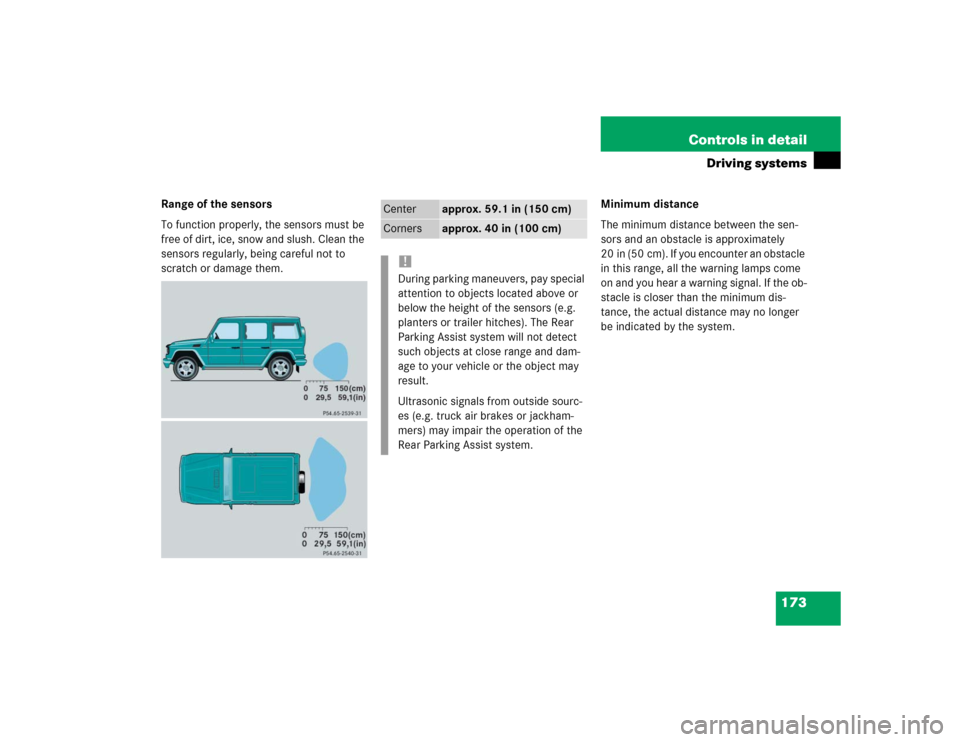
173 Controls in detail
Driving systems
Range of the sensors
To function properly, the sensors must be
free of dirt, ice, snow and slush. Clean the
sensors regularly, being careful not to
scratch or damage them.Minimum distance
The minimum distance between the sen-
sors and an obstacle is approximately
20 in (50 cm). If you encounter an obstacle
in this range, all the warning lamps come
on and you hear a warning signal. If the ob-
stacle is closer than the minimum dis-
tance, the actual distance may no longer
be indicated by the system.
Center
approx. 59.1 in (150 cm)
Corners
approx. 40 in (100 cm)
!During parking maneuvers, pay special
attention to objects located above or
below the height of the sensors (e.g.
planters or trailer hitches). The Rear
Parking Assist system will not detect
such objects at close range and dam-
age to your vehicle or the object may
result.
Ultrasonic signals from outside sourc-
es (e.g. truck air brakes or jackham-
mers) may impair the operation of the
Rear Parking Assist system.